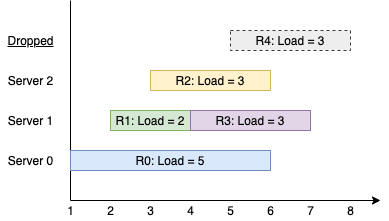LeetCode-in-Java
1606. Find Servers That Handled Most Number of Requests
Hard
You have k servers numbered from 0 to k-1 that are being used to handle multiple requests simultaneously. Each server has infinite computational capacity but cannot handle more than one request at a time. The requests are assigned to servers according to a specific algorithm:
- The
ith(0-indexed) request arrives. - If all servers are busy, the request is dropped (not handled at all).
- If the
(i % k)thserver is available, assign the request to that server. - Otherwise, assign the request to the next available server (wrapping around the list of servers and starting from 0 if necessary). For example, if the
ithserver is busy, try to assign the request to the(i+1)thserver, then the(i+2)thserver, and so on.
You are given a strictly increasing array arrival of positive integers, where arrival[i] represents the arrival time of the ith request, and another array load, where load[i] represents the load of the ith request (the time it takes to complete). Your goal is to find the busiest server(s). A server is considered busiest if it handled the most number of requests successfully among all the servers.
Return a list containing the IDs (0-indexed) of the busiest server(s). You may return the IDs in any order.
Example 1:

Input: k = 3, arrival = [1,2,3,4,5], load = [5,2,3,3,3]
Output: [1]
Explanation:
All of the servers start out available.
The first 3 requests are handled by the first 3 servers in order.
Request 3 comes in. Server 0 is busy, so it’s assigned to the next available server, which is 1.
Request 4 comes in. It cannot be handled since all servers are busy, so it is dropped.
Servers 0 and 2 handled one request each, while server 1 handled two requests. Hence server 1 is the busiest server.
Example 2:
Input: k = 3, arrival = [1,2,3,4], load = [1,2,1,2]
Output: [0]
Explanation:
The first 3 requests are handled by first 3 servers.
Request 3 comes in. It is handled by server 0 since the server is available.
Server 0 handled two requests, while servers 1 and 2 handled one request each. Hence server 0 is the busiest server.
Example 3:
Input: k = 3, arrival = [1,2,3], load = [10,12,11]
Output: [0,1,2]
Explanation: Each server handles a single request, so they are all considered the busiest.
Constraints:
1 <= k <= 1051 <= arrival.length, load.length <= 105arrival.length == load.length1 <= arrival[i], load[i] <= 109arrivalis strictly increasing.
Solution
import java.util.ArrayList;
import java.util.Comparator;
import java.util.List;
import java.util.PriorityQueue;
import java.util.TreeSet;
public class Solution {
static class Server {
final int id;
final int busyTime;
public Server(int id, int busyTime) {
this.id = id;
this.busyTime = busyTime;
}
}
public List<Integer> busiestServers(int k, int[] arrival, int[] load) {
TreeSet<Integer> available = new TreeSet<>();
PriorityQueue<Server> busy = new PriorityQueue<>(Comparator.comparingInt(a -> a.busyTime));
int[] requestCount = new int[k];
int n = arrival.length;
for (int id = 0; id < k; id++) {
available.add(id);
}
for (int i = 0; i < n; i++) {
int defaultServer = (i % k);
while (!busy.isEmpty() && busy.peek().busyTime <= arrival[i]) {
Server top = busy.poll();
available.add(top.id);
}
if (available.isEmpty()) {
continue;
}
Integer nextServer = available.ceiling(defaultServer);
nextServer = (nextServer != null) ? nextServer : available.ceiling(0);
int requestEnd = arrival[i] + load[i];
available.remove(nextServer);
busy.add(new Server(nextServer, requestEnd));
requestCount[nextServer]++;
}
int maxRequests = Integer.MIN_VALUE;
List<Integer> busiestServers = new ArrayList<>();
for (int id = 0; id < k; id++) {
maxRequests = Math.max(maxRequests, requestCount[id]);
}
for (int id = 0; id < k; id++) {
if (requestCount[id] == maxRequests) {
busiestServers.add(id);
}
}
return busiestServers;
}
}

